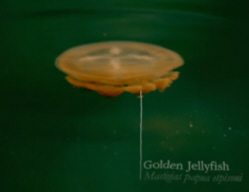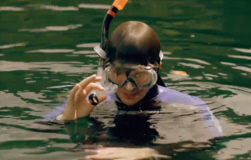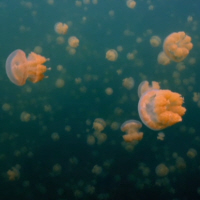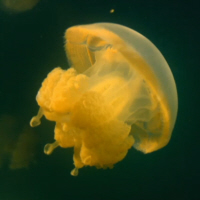Golden Jellyfish
Palau, Micronesia
What is Life?

Golden Jellyfish
Today, life on Earth is so diverse, it covers so much of the planet that you can find places like this lake, where it's effectively its own sealed
ecosystem. It's salt water, it's connected to the sea, but it's only connected through small channels through the rock. So that means that the marine
life in here is effectively isolated.
This is the Golden Jellyfish, a unique subspecies only found in this one lake on this one island, in the tiny Micronesian republic of Palau.
They used to live like most jellyfish, cruising the open ocean, catching tiny creatures, zooplankton, in their long tentacles. But today their
tentacles have all but disappeared because the Golden Jellyfish have evolved to do something that very few other animals can do.
It really is incredible. There are, I want to say millions of jellyfish, as far as you can see, all the way down till the light vanishes there are
jellyfish. And you can see they've congregated in the sun. If you go over there to bear the lake is in shade, there are just none. They are in this
pool of light, beneath the sun. There are millions of them. Beautifully elegant things just floating around. I'm not being unduly hyperbolic, it's
quite remarkable.
This lake is home to over 20 million jellyfish. Whose success comes down to a remarkable adaptation.

Brian Cox snorkelling with Jellyfish

Golden Jellyfish
Their bodies play host to thousands of other organisms – photosynthetic algae that harvest energy directly from sunlight. The jellyfish engulf
the algae as juveniles, and by adulthood algal cells make up around 10% of their biomass. Grouped into clusters of up to 200 individuals, they
live inside the jellyfish's own cells. The Golden Jellyfish uses algae to get most of its energy from photosynthesis.
They go to the surface and gently… wow, there is one there. They are gently turning. The reason they do that is to give all their algae an equal
dose of sunlight. So they are quite democratic creatures, just making sure they get as much food as they can.
They tell me they don't sting. But I'm sure I've got a tingling from it. And it's not just their anatomy that is adapted to harvest solar energy.
Every morning as the sun rises, the jellyfish begin to swim towards the east. As the sun tracks across the sky, they move back again towards the
west, where they spend their night.

Elegant Jellyfish
So the jellyfish have this beautiful, intimate and complex relationship with the position of the sun in the sky. As sunlight is captured
by their algae, it is converted into chemical energy. Energy they use to combine simple molecules, water and carbon dioxide, to produce a
far more complex one. Glucose.
Once absorbed by the jellyfish, glucose and other molecules not only power their daily voyage across the lake, they provide the basic building
blocks the jellyfish use to grow the elegant and complex structures of their bodies.
So the jellyfish, through their symbiotic algae, absorb the light, the energy from the sun, and they use it to live, to power their processes of
life. And that's true, directly or indirectly, for every form of life on the surface of our planet. But things are a little bit more interesting than
that, because energy is neither created nor destroyed. So life it doesn't eat it somehow, it doesn't use it up, it doesn't remove it from the
universe. So what does it do?



